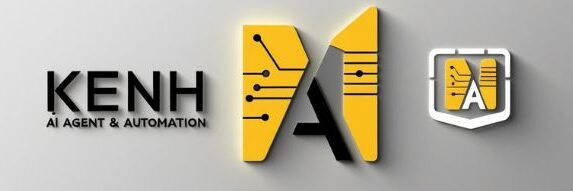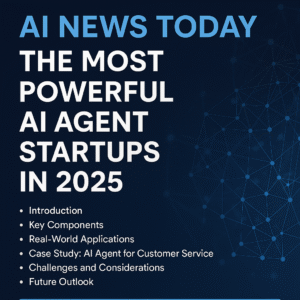What is a Multi-Agent AI System and How It Works
The future of artificial intelligence is no longer about one model doing everything, but multiple intelligent agents working together toward a goal.
This is the core of multi-agent AI systems—and in 2025, it’s powering everything from customer service to product development to creative automation.
Let’s break down how multi-agent systems work, the role of the MCP (Multi-agent Collaborative Process) framework, and how tools like GPT-4.5, Claude AI, and AutoGPT are making this future real—today.
1. The Rise of AI Agents
An AI Agent is more than a chatbot. It’s a self-directed system that can:
Perceive inputs (text, speech, data)
Analyze context
Make decisions autonomously
Take actions in an environment (digital or physical)
AI agents are now used in:
Marketing & content creation
Workflow management
Data analysis
Customer support
Product design
Research and summarization
But what happens when a single agent isn’t enough?
That’s where multi-agent AI systems come in.
2. What is a Multi-Agent AI System?
A Multi-Agent AI System is a collection of AI agents that work collaboratively, each with its own specialization, memory, and goal—but aligned to serve a common objective.
Think of them as:
A digital team of coworkers
Each has domain-specific skills
They communicate, delegate, and reason with each other
They operate in parallel, often in real time
Example:
Agent A researches customer feedback
Agent B writes marketing content
Agent C deploys the content and tracks performance
Agent D optimizes future content based on results
This is not science fiction—it’s already deployed via AutoGPT, LangGraph, and MagicLight AI Agent Builder.
3. Why Multi-Agent is Better than One Big AI
| Single-Agent Systems | Multi-Agent Systems |
|---|---|
| General-purpose, but limited scope | Specialized agents handle complex tasks collaboratively |
| Harder to scale workflows | Easy to scale by adding agents |
| Slower response time | Parallel execution improves speed |
| No internal coordination | Built-in negotiation and delegation |
Just like a real-world company, dividing labor and responsibility makes the entire system smarter, faster, and more efficient.
4. Introducing the MCP Framework
The Multi-agent Collaborative Process (MCP) is the blueprint that enables intelligent agent coordination.
MCP Includes:
Agent memory sharing
Goal alignment logic
Conflict resolution protocols
Task delegation patterns
Continuous learning and feedback loops
MCP acts as the operating system for your AI team.
It’s what turns chaos into coordination.
5. How It Actually Works (Step-by-Step)
Let’s walk through a typical multi-agent interaction using MCP:
🎯 GOAL: Write and publish a weekly AI newsletter
1. Trigger event
AutoGPT receives a task: “Create and schedule this week’s AI digest.”
2. Task decomposition (AutoGPT / MCP)
Breaks down the job:
Topic research
Article writing
Image generation
Email formatting
Sending & reporting
3. Agent assignment
Claude AI → Research articles and summarize
GPT-4.5 → Write the newsletter draft
Midjourney agent → Generate image
Zapier Agent → Format and schedule email
Analytics Agent → Track open and click rates
4. Collaboration and iteration
Agents communicate back via a shared context: “Claude says these trends are hot → GPT uses them → Midjourney aligns visuals → Email is crafted and queued.”
5. Delivery + feedback loop
Analytics agent monitors performance and feeds back insight for next week.
All without a human touching it.
6. Tools That Support Multi-Agent Systems in 2025
| Tool | Role in the Stack |
|---|---|
| Claude AI | Research, long-context summarization, QA agent |
| GPT-4.5 | Creative content, logic reasoning, code generation |
| AutoGPT | Task orchestration, workflow manager |
| MagicLight | No-code agent builder and workflow trigger |
| LangGraph | Chain-based multi-agent reasoning framework |
| Zapier | Connects outputs into real tools (email, calendar, CMS) |
These tools integrate to form the MCP-powered agent ecosystem.
7. Benefits of Multi-Agent Systems
✅ Modular Thinking
Scale your system by adding new agents.
✅ Parallel Execution
Speed up task completion dramatically.
✅ Specialization
Each agent improves its own domain over time.
✅ Autonomous Feedback Loops
Systems that get smarter—automatically.
✅ Enterprise-Ready
Works across content, operations, R&D, marketing, support, etc.
8. How to Deploy Your First Multi-Agent Workflow (No Coding)
You don’t need to be a developer to use this.
Step-by-Step:
Choose a goal (e.g. content production, lead gen, onboarding)
Identify 2–4 tasks in that process
Assign tools/agents to each (Claude for research, GPT for writing…)
Connect them using MagicLight, Zapier, or LangGraph
Test, iterate, improve
🧠 Pro tip: Start with prebuilt agents in MagicLight to save time.
9. Use Cases Across Industries
| Industry | Application |
|---|---|
| Marketing | Campaign automation, content pipelines, email testing |
| HR | Resume screening, interview scheduling, onboarding workflows |
| E-commerce | AI product descriptions, customer support agents, sales assistants |
| Healthcare | Triage bots, medical Q&A agents, scheduling systems |
| Education | Personalized tutoring, curriculum planners, grading bots |
Every team can become a smart team with multi-agent AI.
10. The Future: Toward AGI via Multi-Agent Intelligence?
Many researchers believe true Artificial General Intelligence (AGI) won’t come from a single model, but from multi-agent collaboration at scale.
Like the human brain—a network of specialized modules—the future of AI may be a network of agents, working in harmony under frameworks like MCP.
We’re not there yet—but we’re closer than ever.
Final Thoughts
Multi-agent systems aren’t just a trend—they’re a leap in how we think about automation, intelligence, and productivity.
With tools like GPT-4.5, Claude AI, and platforms like AutoGPT and MagicLight, you can begin building your own intelligent workforce—today.
🚀 Want to build your own AI agent system?
Start automating real workflows with Claude, GPT-4.5, and AutoGPT—without writing a single line of code.
👉 Get started with MagicLight now

